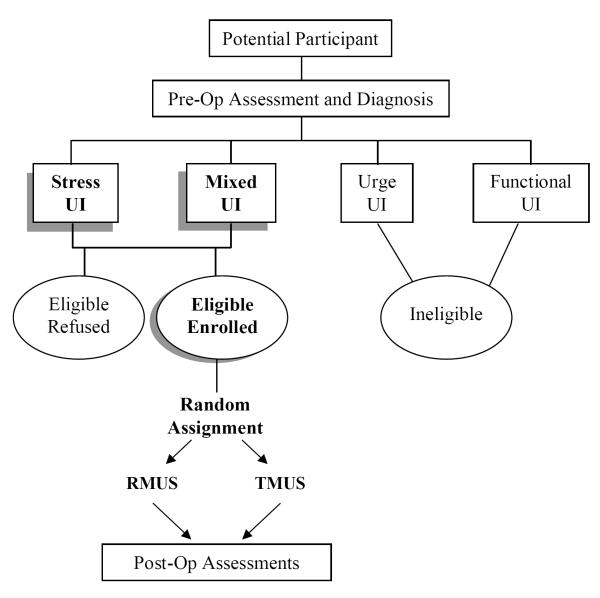Abstract
Objective
Mid-urethral slings (MUS) are increasingly common surgical procedures for the treatment of stress urinary incontinence (SUI) in women. There are currently no adequately powered trials with sufficient length of follow-up comparing the efficacy or safety of the transobturator and retropubic MUS. As a result, no selection criteria are available to guide surgeons or patients. This article describes the methodology and rationale for the Trial Of Mid-Urethral Slings (TOMUS).
Patients and Methods
The primary aims of this randomized controlled trial is to compare subjective and objective success rates for urinary incontinence (UI) at 12 and 24 months following retropubic and transobturator MUS procedures. Secondary aims are to compare the resolution of overall and stress-specific UI, morbidity, the time to adequate voiding, satisfaction, and quality of life in the two groups. TOMUS will also assess the clinical utility of pre-operative urodynamics in women undergoing MUS procedures.
The primary outcome will be obtained at 12 months and 24 months. The definition of treatment success is two-fold. Objective treatment success is defined by a negative stress test, a negative 24-hour pad test and no retreatment for SUI. Subjective treatment success is defined by no self-reported leakage on 3-day diary and no self-reported SUI symptoms. Enrollment began April 2006 and is expected to be complete in 2 years.
Conclusions
The TOMUS trial is designed to provide outcome and safety information to pelvic surgeons and their patients on the two most commonly performed MUS techniques.
Keywords: Midurethral slings, Randomized surgical trial, Tension free vaginal sling, Transobturator, Urinary incontinence, Urodynamics
Introduction
New surgical therapies for the treatment of stress urinary incontinence (SUI) are developed and offered as standard of care without adequate scientific evaluation of their effectiveness or safety. Estimates place the number of different surgical procedures for SUI between 100 and 150 [1, 2]. The MUS procedures were developed in an effort to provide patients with a less invasive therapeutic option for surgical treatment of SUI than the traditional sling and Burch procedures, without compromising efficacy. The retropubic midurethral sling (RMUS) was first introduced by Ulmsten [3] in 1996 as the Tension Free Vaginal Tape (TVT) procedure and has become one of the predominant surgical procedures for treating SUI. Subsequently, a transobturator approach to the MUS was developed as a potentially safer alternative to the RMUS by avoiding the retropubic space and instead passing trocars through the obturator canal [4]. While early data suggest similar efficacy for the two approaches, the data are from case series, non-randomized trials and underpowered randomized clinical trials (RCT) not designed to adequately assess differences between the two procedures [5-9].
The 1997 AUA Surgical Treatment of Stress Urinary Incontinence Guidelines emphasized that the urinary incontinence literature was insufficient to compare surgical procedures performed for the treatment of SUI [10]. More recently, Nygaard and Heit [11] emphasized the importance of evaluating new therapies in randomized clinical trials before accepting them into general clinical use. It is critical to compare the efficacy and safety of the retropubic and transobturator approaches to the MUS, given the limited efficacy data and the rapid increase in the number of transobturator MUS procedures being performed.
This paper describes the design and methodology of a multi-center randomized surgical trial comparing the efficacy and safety of retropubic and transobturator MUS procedures. Results of this trial will allow clinicians to provide evidence-based outcome and safety data to women with SUI who are considering minimally invasive anti-incontinence procedures.
Methods
TOMUS (Trial Of Mid-Urethral Slings) is being conducted by the Urinary Incontinence Treatment Network (UITN), a cooperative network consisting of urologists and urogynecologists at nine clinical centers and a biostatistical coordinating center (BCC). The UITN is sponsored by the National Institute of Diabetes and Digestive and Kidney Diseases (NIDDK) and the National Institute of Child Health and Human Development (NICHD). An independent 11-member Data Safety and Monitoring Board (DSMB) meets biannually to review the conduct and safety of the trial.
Study design
TOMUS is a two-arm, unmasked, multi-center RCT (Figure 1) comparing RMUS to TMUS. There are two primary aims: to compare the (1) objective and (2) subjective success rates of the two procedures for the resolution of UI at 12 and 24 months. The a priori primary endpoint for evaluating success is at 12 months. Secondary aims include assessment of complications, resolution of overall and stress-specific UI, patient bother from UI symptoms, quality of life (QOL), patient satisfaction, sexual function, and time to resumption of normal activities. A separate secondary aim is to assess the clinical utility of preoperative urodynamics.
Figure 1. Study Design.
Patient flow diagram.
Patients are randomized in the operating room after the administration of anesthesia using a telephone automated randomization system at the BCC. Each site has sealed envelopes containing random assignments as a back-up system. Randomization is stratified by clinical site, using permuted blocks.
The protocol was approved by the DSMB of the UITN and Institutional Review Boards of all participating centers. Written informed consent is obtained in all women who enroll in the study. The trial will take approximately 4 years (2 years to recruit and 2 years minimum follow-up) and began enrolling patients in April of 2006.
Study population
Women diagnosed with stress predominant urinary incontinence by symptoms on questionnaire and a positive standardized stress test and who desire surgical treatment are eligible. Inclusion and exclusion criteria are listed in Table 1.
Table 1.
Inclusion and exclusion criteria
Inclusion Criteria
|
Exclusion Criteria
|
Patient can be rescreened after respective time interval has been met.
Medical, Epidemiologic, and Social Aspects of Aging questionnaire.
“Partum” is defined as a delivery or other termination that occurs after 20 weeks gestation.
Primary outcomes
Treatment success at 12 months post surgery will be assessed both objectively (clinically) and subjectively (patient report). Objective treatment success is defined as a negative stress test, a negative pad test (<15 grams/24 hours) and no retreatment of SUI. Subjective treatment success is defined as no self-reported leakage by a three-day voiding diary, no self-reported stress-type urinary incontinence symptoms and no retreatment of SUI. Treatment failure can be diagnosed any time after 3 months post-operatively. Retreatment includes behavioral, pharmacologic and surgical treatment for SUI symptoms and can occur any time post-surgery.
Assessment schedule
Data are collected by clinical examination, patient interview and self-administered survey at in-person visits pre-operatively and at 2 weeks, 6 weeks, and 6, 12 and 24 months post-operatively (Table 2). Patients who require re-treatment for SUI receive the 12-month assessment battery prior to the initiation of retreatment. Such patients remain in the study for follow-up as scheduled.
Table 2.
Schedule of measurements
|
Baseline
(pre-op) |
Op | 2 wk a | 6 wk a | 6mo | 12 mo b | 24 mo | |
|---|---|---|---|---|---|---|---|
| Primary outcomes | |||||||
| Stress test |
 c
c
|

|

|

|
|||
| Pad test |
 d
d
|

|

|

|
|||
| New interventions or re-treatment |

|

|

|

|

|
||
| MESA Questionnaire |
 d
d
|

|

|

|

|
||
| Voiding diary |
 d
d
|

|

|

|
|||
| Secondary Outcomes | |||||||
| Quality of life |
 d
d
|

|

|

|
|||
| Patient bother |
 d
d
|

|

|

|

|

|
|
| Voiding function | |||||||
| Post void residual |
 c
c
|

|

|

|

|

|

|
| Self-report |
 d
d
|

|

|

|

|

|
|
| Pain | |||||||
| Self-reporte |
 d
d
|

|

|

|

|

|

|
| Exam |
 d
d
|

|

|
||||
| Patient satisfaction |

|

|

|
||||
| Resumption of activities |
 d
d
|

|

|

|
|||
| Sexual function |
 d
d
|

|

|

|
|||
| Complications/morbidity |

|

|

|

|

|

|
|
| Urodynamics |
 c
c
|

|
|||||
| Urine dipstick |
 d
d
|

|

|

|

|

|
|
| Cost Measures |
 d
d
|

|

|
||||
| Independent Variables | |||||||
| Sociodemographic |

|
||||||
| History and Physical |
 d
d
|

|

|

|
|||
| Q-tip test |
 c
c
|
||||||
| Medication audit |
 d
d
|

|

|

|

|

|
|
| Intervening Variables | |||||||
| Prolapse Assessment a |
 d
d
|

|

|
||||
| Operative measures |

|
||||||
| Depression |
 d
d
|

|

|

|
|||
| Patient expectations |
 d
d
|
Visit frequency between 2-6 weeks will depend on voiding function.
Measure must be repeated if patient is not randomized within 6 months of completion.
Measure must be repeated if patient is not randomized within 12 months of completion.
Or at time of treatment failure, if earlier. If patient is surgically retreated and therefore has UDS prior to 12-months as part of treatment failure battery, UDS are not done again at 12-months.
Post-operative self-report: daily until pain resolves or 4 weeks post-op.
Measures
Assessment of urinary incontinence
The presence of urinary incontinence will be assessed with the Medical, Epidemiologic, and Social Aspects of Aging (MESA) questionnaire [12], a three-day voiding diary [13-15], a 24-hour pad test [16, 17], and a provocative stress test standardized to position and a bladder volume of 300 mL [18].
Other measures
The following measurement tools will be used to assess the secondary outcomes: quality of life by the International Consultation on Incontinence Questionnaire [19] and Incontinence Impact Questionnaire [20]; symptom bother by the Urogenital Distress Inventory [20]; sexual function by the Prolapse/Urinary Incontinence Sexual Questionnaire [21, 22]; treatment satisfaction by a self-administered satisfaction questionnaire [23] and the Patient Global Impression of Severity and Improvement questions [24]; and resumption of normal activities by the Activities Assessment Scale [25]. Sociodemographic and clinical characteristics of the participants are also assessed.
Cost measures
Data will also be collected regarding the use of incontinent aid products using the Incontinence Expense questionnaire [26], health care utilization [27] and patient preferences for states of health. Direct costs will be calculated using Medicare resource-based relative value scale charges for physician services as a proxy for societal cost [28]. Utilities (or patient preferences) associated with urinary incontinence will be measured with the Health Utilities Index Mark 3 [28, 29] and willingness to pay for urinary incontinence improvement [30].
Complications
Complications are specifically defined in the study protocol to ensure consistency in reporting between investigators and between sites. A standardized assessment of complication severity across sites will be performed using a validated severity classification system [31]. In order to detect small differences between the RMUS and TMUS procedures, post-operative assessment will begin immediately after discharge from the hospital and continue for 2 weeks. Post-operative voiding will be measured in many dimensions including patient questionnaire, objective documentation of the return to normal voiding, long-term assessment of urodynamic variables, and the need for treatment. Differences in pain severity and duration between the two procedures will be measured using a daily pain diary and a physical examination assessment at baseline, and at 2 and 6 weeks after surgery. The four-item McCarthy pain scale [32] assesses severity and degree of bother from pain at rest and with various activities after surgery.
Urodynamic Studies (UDS)
Urodynamic tests are performed preoperatively and at 12 months in all patients (Table 3). Standardized testing procedures and interpretation guidelines were developed by a urodynamics work group utilizing the methods, definitions and units recommended by the International Continence Society Standardisation Committee of Good Urodynamic Practice and the Good Urodynamics Practice Guidelines [33, 34]. The Network has established excellent inter-rater reliability between local and central reviewers for UDS parameters in previous network trials using similar UDS methods [35].
Table 3.
Standardized urodynamic studies
| Test | Measures |
|---|---|
| Non-instrumented uroflow | Maximum flow rate |
| Mean flow rate | |
| Time to maximum flow | |
| Voided volume | |
| Post void residual | |
| Flow pattern | |
| Urethral pressure profile | Maximum urethral closure pressure |
| Functional urethral length | |
| Cystometrogram | Baseline and capacity pressures |
| First desire | |
| Strong desire | |
| Maximum cystometric capacity | |
| Compliance | |
| Valsalva leak point pressure | |
| Involuntary detrusor contraction | |
| Pressure flow | Maximum flow rate |
| Detrusor pressure at maximum flow | |
| Time to maximum flow | |
| Voided volume | |
| Voiding mechanism | |
| Post void residual |
To ensure that pre-operative UDS results do not influence patient selection, surgical technique or post-operative management of voiding symptoms, pre-operative UDS will be performed after enrollment. The UDS tracings will be interpreted by a non-treating, study surgeon while the treating surgeon remains masked to UDS results. Postoperatively, the treating physicians may request to review the pre-operative UDS in order to treat post-operative symptoms; however, they will be asked to specify their reasons for the review and their diagnosis before and after reviewing the UDS.
Study treatments
The specific MUS procedures performed in this study are limited to the original retropubic MUS procedure, the TVT ™ (Gynecare), and one of two transobturator MUS procedures, the Tension Free Vaginal Tape – Obturator (TVT-O™; Gynecare) or the Monarc™ (American Medical Systems). Key aspects of the procedures have been standardized across surgeons and sites to improve internal and external validity. Each surgeon has pre-selected which transobturator MUS technique he/she will use during the study. A study surgeon must have performed a minimum of five retropubic and five transobturator MUS procedures and his/her principal investigator must have observed him/her performing the key aspects of each procedure before the surgeon can be approved as a study surgeon.
Concomitant prolapse repair surgery is allowed only if it is performed vaginally and without the use of synthetic graft material. Additionally, no biologic graft material is allowed in the anterior compartment. Surgeons are expected to declare the type of concomitant surgery they plan to perform prior to randomization.
Statistical analysis
The current study is designed to detect equivalence in the success rates of the two procedures within a clinically meaningful range of equivalence (Table 4). Prior studies report 12-month cure rates as high as 90% and 24-month cure rates of approximately 60-70%. If the two procedures have the same underlying cure rate, samples of 250 participants in each group achieve 80% power at a 5% significance level using a two-sided equivalence test of proportions. An 85% follow-up is anticipated; therefore, 294 women will be randomly assigned to each surgical arm.
Table 4.
Power calculations based on differing cure rates
| Common cure rate | Range of equivalence (percentage points) |
|---|---|
| 70% | 12 |
| 80% | 11 |
| 90% | 8 |
The percentage of women in each treatment arm who meet the objective and subjective definitions of success at 12 and 24 months post treatment will be computed using Kaplan-Meier time to event methods, controlling for study site. To test the equivalence of the two percentages at each follow-up time point, the difference in percent success with 95% confidence limits will be computed. The null hypothesis will be rejected and the procedures will be considered equivalent if the confidence interval lies entirely within the range −0.l2 to +0.12.
Analysis of continuous outcomes such as the quality of life subscales will be based on change from baseline. Prognostic models will be developed using baseline urodynamic testing results and other baseline covariates to explore the extent to which baseline measures can be used to predict surgical success. Time-to-event methods will be utilized to characterize time to normal voiding.
The decision to stop the trial early due to safety or efficacy concerns is at the discretion of the DSMB. An interim statistical analysis of the primary study hypothesis will be performed when approximately half of the expected failures have occurred. Repeated confidence intervals, as recommended by Jennison and Turnbull [36], were selected for use in this study because of the flexibility in the situation where the formal stopping rule may not be followed. Interim monitoring of treatment failures will be conducted using Kaplan-Meier time to event analysis to estimate the cumulative probability of failure. The methodology of Lan and DeMets [37] will be used to implement an O’Brien-Fleming stopping boundary for this monitoring. The stopping boundary will determine the level of confidence for the interim confidence interval calculation.
Discussion
Choice of mid-urethral sling technique
The currently available MUS procedures attempt to distinguish themselves by highlighting differences in technique and type of sling material. How these differences impact the efficacy and/or morbidity of the procedures is not known TOMUS is designed to isolate one of these variables, the anatomic location (retropubic versus transobturator) through which the trocars are passed during placement of the sling, and to compare the efficacy and morbidity of these approaches in the treatment of SUI.
The original retropubic MUS is cited in over 541 published articles with overall long-term objective success rates of 81% at 91 months [38]. These success rates are similar to those reported for the Burch colposuspension and rectus fascia slings [39, 40]. RCTs comparing the TVT with the allogenic suburethral sling [41], laparoscopic Burch [42, 43] and open Burch procedures [44, 45] demonstrate similar success rates for TVT versus these traditional procedures for the treatment of SUI. Complications such as retropubic hematoma, bladder injury, and rarely more life-threatening injuries to bowel or major blood vessels, while infrequent, have been reported [5, 46, 47]. Modifications to the TVT have been in response to these complications and clinicians’ concern about passing trocars through the retropubic space. Modifications have included both suprapubic and transobturator approaches. The limited comparative studies between TVT and the suprapubic approach have not demonstrated any advantage over the TVT with regard to morbidity, and they provide conflicting data with regard to efficacy [48, 49].
The transobturator approach, on the other hand, offers the potential advantage of avoiding the retropubic space completely. TMUS procedures are performed by one of two techniques, differing only in the direction the trocar is passed through the obturator foramen; the lateral to medial technique described by Delorme or the medial to lateral technique described by de Leval [4, 50]. Theoretically the direction the trocars are passed can result in differences in the size of the vaginal incision, the amount of periurethral dissection, and the proximity of the trocar to the obturator neurovascular bundle as it passes through the obturator foramen. A three-arm design comparing the two TMUS approaches to each other as well as to the RMUS approach was considered. However, without evidence or plausible reasons that one of the TMUS techniques was better, the increased cost and recruitment time needed for the larger sample size could not be justified [51, 52].
Choice of sling material
The current MUS products utilize a variety of mesh materials, each with specific biomaterial characteristics. Specific mesh characteristics are thought to facilitate macrophage response and tissue in-growth and thus are theoretically associated with lower erosion and/or infection rates. These characteristics include knitted polypropylene material, pore size greater than 75 micrometers, minimal interstices, and low density [53]. The TVT ™ mesh as well as six of the other transobturator mesh materials meet those criteria. Papas et al. [54] performed biomechanical analyses on the six transobturator mesh materials and compared the following biomaterial characteristics to the TVT: tensile behavior, structural integrity, textile properties, macroscopic knit pattern, mesh edges and mesh modifications designed to improve intra-operative handling (e.g., tensioning suture, heat sealing). This analysis revealed marked differences between the TVT mesh and all but one (Monarc) of the six other mesh materials. Other investigators have reached similar conclusions with regard to the similarities between MUS mesh materials [55]. Whether these mesh characteristics are important for safety and/or efficacy in stress incontinence surgery is not known. Nevertheless, because they could potentially confound the primary or secondary outcomes, the decision was made to exclude the other five mesh materials from this trial.
In selecting which MUS products to include in the TOMUS trial, we chose to use the gold standard MUS as the control and to limit the confounding variables to the location of the trocar passage. Therefore, the MUSs that will be utilized in the TOMUS trial are limited to the TVT in the retropubic group and either the TVT-O or the Monarc in the transobturator group.
Outcome measures
The optimal method for assessing outcomes after incontinence surgery remains unclear, especially because patient satisfaction and traditional objective cure measures are not well correlated. There are limited data using the global satisfaction and improvement measures as a primary outcome after continence surgery. The TOMUS study uses a composite primary outcome measure, with objective and subjective components, similar to the outcome measures utilized in the UITN’s recently completed SISTEr trial [23] comparing the Burch procedure to autologous fascial slings. It is hoped that the use of similar outcome measures, standardized across all clinical sites, will better compare the midurethral sling outcomes with the more traditional procedures.
There is an increasing focus on patient satisfaction when treating QOL disorders such as incontinence. Three validated condition-specific QOL instruments [20] and two satisfaction measures [19, 24] will capture the impact of incontinence on everyday life; the impact of incontinence on various activities, roles and emotional states; and the bother from incontinence symptoms. Little is known about the effect of urinary incontinence or continence surgery on sexual function. Sexual function, bowel function and return to normal activities will be captured with validated instruments [21, 25]. The increasingly important economic impact of incontinence and treatment outcomes will be measured as it was in the SISTEr trial.
Complications and known side effects of surgery can dramatically impact patient satisfaction after treatment of QOL disorders. One of the major priorities of this protocol is to compare the morbidity of RMUS and TMUS. Three of the most common adverse conditions associated with patient dissatisfaction after stress incontinence surgery are voiding dysfunction, urge incontinence and pain. The TOMUS protocol standardizes definitions for these conditions, the tools used to measure them and the timing of assessments across all centers.
Urodynamics
UDS are commonly performed as part of the preoperative evaluation in women with SUI despite the high cost, the invasiveness of the test and the controversy regarding their reliability. Advocates claim that UDS provide valuable information in predicting outcomes and identifying risk factors for failure of the procedures. The TOMUS trial affords an excellent opportunity to examine the clinical utility of pre-operative UDS by limiting the use of UDS data in the pre-and peri-operative decision making process. This will be accomplished by blinding the surgeon to the pre-operative urodynamics data.
The TOMUS urodynamics protocol will assess the value of the two most common urethral function studies, the Valsalva Leak Point Pressure (VLPP) and the Urethral Pressure Profile (UPP). Neither of these measures have demonstrated good correlation with each other, with other measurements of incontinence severity or with clinical outcomes [56]. Pre-operative voiding parameters from non-instrumented flow and pressure-flow studies will be correlated with post-operative voiding function to assess whether post-operative voiding dysfunction can be predicted.
Investigators who value baseline urodynamic information to help manage postoperative voiding complaints or to determine whether symptoms are associated with de novo changes in bladder function will be allowed to utilize the pre-operative UDS after declaring their clinical diagnosis, their treatment plan and the clinical question they hope to answer with the pre-operative UDS data. They will also record any subsequent changes in management based on the UDS data. Finally, the post-operative UDS will provide insight into the effects of the MUS procedures on bladder function at one year post-operatively.
Conclusion
TOMUS is a registered, randomized surgical trial which is designed to compare the efficacy of the most commonly utilized minimally invasive surgical treatments for SUI, the retropubic and transobturator MUS procedures. The primary outcome measure is resolution of UI based on subjective (questionnaire and diary) and objective (pad tests and stress test) assessments. Several secondary outcome measures will also be carefully evaluated, including an analysis of preoperative factors that may suggest favoring one procedure over the other. Masking of study surgeons to all UDS procedures assures that UDS results do not influence choice of surgical treatment. UDS will be conducted in a standardized fashion and rigorously reviewed. Therefore it is also hoped that this study will discern whether pre-operative UDS is associated with outcomes or morbidity in either of the treatment arms.
Acknowledgments
Supported by cooperative agreements from the National Institute of Diabetes and Digestive and Kidney Diseases, U01 DK58225, U01 DK58229, U01 DK58234, U01 DK58231, U01 DK60379, U01 DK60380, U01 DK60393, U01 DK60395, U01 DK60397, and 60401.
Support was also provided by the National Institute of Child Health and Human Development and Office of Research in Women’s Health, NIH.
APPENDIX. THE URINARY INCONTINENCE TREATMENT NETWORK
STEERING COMMITTEE
William Steers, MD, Chair (University of Virginia Charlottesville VA); Ananias Diokno, MD, Salil Khandwala, MD, (William Beaumont Hospital, Royal Oak, MI and Oakwood Hospital, Dearborn MI; U01 DK58231); Linda Brubaker, MD, MaryPat FitzGerald, MD (Loyola University Medical Center, Maywood, IL; U01 DK60379); Holly E. Richter, PhD, MD, L. Keith Lloyd, MD (University of Alabama, Birmingham, AL; U01 DK60380); Michael Albo, MD, Charles Nager, MD (University of California, San Diego, CA; U01 DK60401); Toby Chai, MD, Harry W. Johnson, MD (University of Maryland, Baltimore, MD; U01 DK60397); Halina M. Zyczynski, MD, Wendy Leng, MD (University of Pittsburgh, Pittsburgh, PA; U01 DK 58225); Philippe Zimmern, MD, Gary Lemack, MD (University of Texas Southwestern, Dallas, TX; U01 DK60395); Stephen Kraus, MD, Thomas Rozanski, MD (University of Texas Health Sciences Center, San Antonio, TX; U01 DK58234); Peggy Norton, MD, Lindsey Kerr, MD (University of Utah, Salt Lake City, UT; U01 DK60393); Sharon Tennstedt, PhD, Anne Stoddard, ScD (New England Research Institutes, Watertown, MA; U01 DK58229); Debuene Chang, MD, John W. Kusek, PhD, Leroy M. Nyberg, MD, PhD (National Institute of Diabetes & Digestive & Kidney Diseases); Anne M. Weber, MD (National Institute of Child Health and Human Development).
CO-INVESTIGATORS
Rowell S. Ashford II, MD; Jan Baker, APRN; Diane Borello-France, PT, PhD; Kathryn L. Burgio, PhD; Seine Chiang, MD; Ash Dabbous, MD; Patricia S. Goode, MD; Lee N. Hammontree, MD; Kimberly Kenton, MD; David Lesser, MD; Karl Luber, MD; Emily Lukacz, MD; Alayne Markland, MD; Shawn Menefee, MD; Pamela Moalli, MD; Kenneth Peters, MD; Elizabeth Sagan, MD; Joseph Schaffer, MD; Amanda Simsiman, MD; Larry Sirls, MD; Robert Starr, MD; R. Edward Varner, MD.
STUDY COORDINATORS
Rosemary Bradt, RNC; Karen Debes, RN; Rosanna Dinh, RN; Judy Gruss, RN; Lynn Hall, RN, MSN, CURN; Alice Howell, RN, BSN, CCRC; Kathy Jesse, RN; D. Lynn Kalinoski, PhD; Kathryn Koches, RN; Barbara Leemon, RN; Karen Mislanovich, RN; Shelly O’Meara, RN; Janese Parent, RN; Norma Pope, RN; Caren Prather, RN; Terry Rogers, RN; Sylvia Sluder, CCRP; Mary Tulke, RN.
BIOSTATISTICAL COORDINATING CENTER
Kimberly J. Dandreo, MSc; Corinne J. Leifer, BA; Susan McDermott, MPH, GNP; Anne Stoddard, ScD (Co-PI); Sharon Tennstedt, PhD (PI); Liane Tinsley, BA: Lisa Wruck ScD; Yan Xu, MS.
DATA SAFETY AND MONITORING BOARD
Elizabeth A.Gormley MD (Chair), Dartmouth-Hitchcock Medical Center, Lebanon NH; Paul Abrams MD, Bristol Urological Institute, Bristol UK; Diedre Bland MD, Blue Ridge Medical Associates, Winston Salem NC; J. Quentin Clemens MD, Northwestern University Medical School, Chicago IL; John Connett PhD, University of Minnesota, Minneapolis MN; William Henderson PhD, University of Colorado, Aurora CO; Dee Fenner MD, University of Michigan, Ann Arbor MI; Sheryl Kelsey PhD, University of Pittsburgh, Pittsburgh PA; Deborah Myers MD, Brown University School of Medicine, Providence RI; Jacek Mostwin MD, Johns Hopkins Hospital, Baltimore MD; Bassem Wadie MBBCh, MSc, MD, Mansoura Urology and Nephrology Center, Mansoura, Egypt.
Footnotes
Clinical Trial Registration Number: NCT00064662
References
- [1].Lose G, Ostergard DR. Medical technology assessment and surgery for stress incontinence. Int Urogynecol J Pelvic Floor Dysfunct. 1999;10:351–352. doi: 10.1007/s001920050057. [DOI] [PubMed] [Google Scholar]
- [2].Nilsson CG. Introduction of a new surgical procedure for treatment of female urinary incontinence. Acta Obstet Gynecol Scand. 2004;83:877–880. doi: 10.1111/j.0001-6349.2004.00381.x. [DOI] [PubMed] [Google Scholar]
- [3].Ulmsten U, Henriksson L, Johnson P, Varhos G. An ambulatory surgical procedure under local anesthesia for treatment of female urinary incontinence. Int Urogynecol J Pelvic Floor Dysfunct. 1996;7:81–85. doi: 10.1007/BF01902378. discussion 5-6. [DOI] [PubMed] [Google Scholar]
- [4].Delorme E. Transobturator urethral suspension: mini-invasive procedure in the treatment of stress urinary incontinence in women [in French] Prog Urol. 2001;11:1306–1313. [PubMed] [Google Scholar]
- [5].David-Montefiore E, Frobert JL, Grisard-Anaf M, Lienhart J, Bonnet K, Poncelet C, et al. Peri-operative complications and pain after the suburethral sling procedure for urinary stress incontinence: a French prospective randomised multicentre study comparing the retropubic and transobturator routes. Eur Urol. 2006;49:133–138. doi: 10.1016/j.eururo.2005.09.019. [DOI] [PubMed] [Google Scholar]
- [6].Neuman M. TVT and TVT-Obturator: comparison of two operative procedures. Eur J Obstet Gynecol Reprod Biol. 2007;131:89–92. doi: 10.1016/j.ejogrb.2006.03.007. [DOI] [PubMed] [Google Scholar]
- [7].Delorme E, Droupy S, de Tayrac R, Delmas V. Transobturator tape (Uratape): a new minimally-invasive procedure to treat female urinary incontinence. Eur Uro. 2004;45:203–207. doi: 10.1016/j.eururo.2003.12.001. [DOI] [PubMed] [Google Scholar]
- [8].Morey AF, Medendorp AR, Noller MW, Mora RV, Shandera KC, Foley JP, et al. Transobturator versus transabdominal mid urethral slings: a multi-institutional comparison of obstructive voiding complications. J Urol. 2006;175:1014–1017. doi: 10.1016/S0022-5347(05)00412-X. [DOI] [PubMed] [Google Scholar]
- [9].Laurikainen E, Valpas A, Kivela A, Kalliola T, Rinne K, Takala T, et al. Retropubic compared with transobturator tape placement in treatment of urinary incontinence: a randomized controlled trial. Obstet Gynecol. 2007;109:4–11. doi: 10.1097/01.AOG.0000249607.82768.a1. [DOI] [PubMed] [Google Scholar]
- [10].Leach GE, Dmochowski RR, Appell RA, Blaivas JG, Hadley HR, Luber KM, et al. Female Stress Urinary Incontinence Clinical Guidelines Panel summary report on surgical management of female stress urinary incontinence. The American Urological Association. J Urol. 1997;158:875–880. doi: 10.1097/00005392-199709000-00054. [DOI] [PubMed] [Google Scholar]
- [11].Nygaard IE, Heit M. Stress urinary incontinence. Obstet Gynecol. 2004;104:607–620. doi: 10.1097/01.AOG.0000137874.84862.94. [DOI] [PubMed] [Google Scholar]
- [12].Herzog AR, Diokno AC, Brown MB, Normolle DP, Brock BM. Two-year incidence, remission, and change patterns of urinary incontinence in noninstitutionalized older adults. J Gerontol. 1990;45:M67–M74. doi: 10.1093/geronj/45.2.m67. [DOI] [PubMed] [Google Scholar]
- [13].Locher JL, Goode PS, Roth DL, Worrell RL, Burgio KL. Reliability assessment of the bladder diary for urinary incontinence in older women. J Gerontol A Biol Sci Med Sci. 2001;56:M32–M35. doi: 10.1093/gerona/56.1.m32. [DOI] [PubMed] [Google Scholar]
- [14].Nygaard I, Holcomb R. Reproducibility of the seven-day voiding diary in women with stress urinary incontinence. Int Urogynecol J Pelvic Floor Dysfunct. 2000;11:15–17. doi: 10.1007/pl00004021. [DOI] [PubMed] [Google Scholar]
- [15].Wyman JF, Choi SC, Harkins SW, Wilson MS, Fantl JA. The urinary diary in evaluation of incontinent women: a test-retest analysis. Obstet Gynecol. 1988;71:812–817. [PubMed] [Google Scholar]
- [16].Jorgensen L, Lose G. Diagnosis of mild stress incontinence in females: 24-hour home pad weighing test versus the 1-hour ward test. Neurourol Urodyn. 1987;6:165–166. [Google Scholar]
- [17].Lose G, Jorgensen L, Thunedborg P. 24-hour home pad weighing test versus 1-hour ward test in the assessment of mild stress incontinence. Acta Obstet Gynecol Scand. 1989;68:211–215. doi: 10.3109/00016348909020991. [DOI] [PubMed] [Google Scholar]
- [18].Shull BL, Halasaka M, Hurt G, Kinn A, Laycock J, Palmtag H, et al. Physical examination. In: Abrams P, Saad K, Wein A, editors. Incontinence: Proceedings of the 1st International Consultation on Incontinence; June 28-July 1, 1998; England: Health Publications Ltd.; 1998. [Google Scholar]
- [19].Avery K, Donovan J, Peters TJ, Shaw C, Gotoh M, Abrams P. ICIQ: a brief and robust measure for evaluating the symptoms and impact of urinary incontinence. Neurourol Urodyn. 2004;23:322–330. doi: 10.1002/nau.20041. [DOI] [PubMed] [Google Scholar]
- [20].Shumaker SA, Wyman JF, Uebersax JS, McClish D, Fantl JA. Health-related quality of life measures for women with urinary incontinence: the Incontinence Impact Questionnaire and the Urogenital Distress Inventory. Continence Program in Women (CPW) Research Group. Qual Life Res. 1994;3:291–306. doi: 10.1007/BF00451721. [DOI] [PubMed] [Google Scholar]
- [21].Rogers RG, Coates KW, Kammerer-Doak D, Khalsa S, Qualls C. A short form of the Pelvic Organ Prolapse/Urinary Incontinence Sexual Questionnaire (PISQ-12) Int Urogynecol J Pelvic Floor Dysfunct. 2003;14:164–168. doi: 10.1007/s00192-003-1063-2. discussion 8. [DOI] [PubMed] [Google Scholar]
- [22].Rogers RG, Kammerer-Doak D, Villarreal A, Coates K, Qualls C. A new instrument to measure sexual function in women with urinary incontinence or pelvic organ prolapse. Am J Obstet Gynecol. 2001;184:552–558. doi: 10.1067/mob.2001.111100. [DOI] [PubMed] [Google Scholar]
- [23].Tennstedt S. Design of the Stress Incontinence Surgical Treatment Efficacy Trial (SISTEr) Urology. 2005;66:1213–1217. doi: 10.1016/j.urology.2005.06.089. [DOI] [PubMed] [Google Scholar]
- [24].Yalcin I, Bump RC. Validation of two global impression questionnaires for incontinence. Am J Obstet Gynecol. 2003;189:98–101. doi: 10.1067/mob.2003.379. [DOI] [PubMed] [Google Scholar]
- [25].McCarthy M, Jr., Jonasson O, Chang CH, Pickard AS, Giobbie-Hurder A, Gibbs J, et al. Assessment of patient functional status after surgery. J Am Coll Surg. 2005;201:171–178. doi: 10.1016/j.jamcollsurg.2005.03.035. [DOI] [PubMed] [Google Scholar]
- [26].Dowell CJ, Bryant CM, Moore KH, Simons AM. Calculating the direct costs of urinary incontinence: a new test instrument. BJU Int. 1999;83:596–606. doi: 10.1046/j.1464-410x.1999.00993.x. [DOI] [PubMed] [Google Scholar]
- [27].Cardinale V. Drug topics: red book. Medical Economics Co, Inc.; Montvale, NJ: 1997. [Google Scholar]
- [28].Feeny D, Furlong W, Boyle M, Torrance GW. Multi-attribute health status classification systems. Health Utilities Index. Pharmacoeconomics. 1995;7:490–502. doi: 10.2165/00019053-199507060-00004. [DOI] [PubMed] [Google Scholar]
- [29].Furlong W, Feeny D, Torrance GW, Goldsmith C, DePauw S, Boyle M, et al. Multiplicative Multi-Attribute Utility Function for the Health Utilities Index Mark 3 (HUI3) System: A Technical Report. McMaster University Centre for Health Economics and Policy Analysis; 1998. McMaster University Centre for Health Economics and Policy Analysis Working Paper No. 98-11. [Google Scholar]
- [30].Kobelt G. Economic considerations and outcome measurement in urge incontinence. Urology. 1997;50:100–107. doi: 10.1016/s0090-4295(97)00602-x. discussion 8-10. [DOI] [PubMed] [Google Scholar]
- [31].Dindo D, Demartines N, Clavien PA. Classification of surgical complications: a new proposal with evaluation in a cohort of 6336 patients and results of a survey. Ann Sur. 2004;240:205–213. doi: 10.1097/01.sla.0000133083.54934.ae. [DOI] [PMC free article] [PubMed] [Google Scholar]
- [32].McCarthy M, Jr, Chang CH, Pickard AS, Giobbie-Hurder A, Price DD, Jonasson O, et al. Visual analog scales for assessing surgical pain. J Am Coll Surg. 2005;201:245–252. doi: 10.1016/j.jamcollsurg.2005.03.034. [DOI] [PubMed] [Google Scholar]
- [33].Abrams P, Cardozo L, Fall M, Griffiths D, Rosier P, Ulmsten U, et al. The standardisation of terminology in lower urinary tract function: report from the standardisation sub-committee of the International Continence Society. Urology. 2003;61:37–49. doi: 10.1016/s0090-4295(02)02243-4. [DOI] [PubMed] [Google Scholar]
- [34].Schafer W, Abrams P, Liao L, Mattiasson A, Pesce F, Spangberg A, et al. Good urodynamic practices: uroflowmetry, filling cystometry, and pressure-flow studies. Neurourol Urodyn. 2002;21:261–274. doi: 10.1002/nau.10066. [DOI] [PubMed] [Google Scholar]
- [35].Nager CW, Albo ME, Fitzgerald MP, McDermott SM, Kraus S, Richter HE, et al. Process for development of multicenter urodynamic studies. Urology. 2007;69:63–67. doi: 10.1016/j.urology.2006.08.1118. discussion 7-8. [DOI] [PMC free article] [PubMed] [Google Scholar]
- [36].Jennison C, Turnbull BW. Group Sequential Methods with Applications to Clinical Trials. Chapman & Hall/CRC; Boca Raton, FL: 2000. [Google Scholar]
- [37].Lan KKG, DeMets DL. Discrete sequential boundaries for clinical trials. Biometrika. 1083;70:659–663. [Google Scholar]
- [38].Nilsson CG, Falconer C, Rezapour M. Seven-year follow-up of the tension-free vaginal tape procedure for treatment of urinary incontinence. Obstet Gynecol. 2004;104:1259–1262. doi: 10.1097/01.AOG.0000146639.62563.e5. [DOI] [PubMed] [Google Scholar]
- [39].Alcalay M, Monga A, Stanton SL. Burch colposuspension: a 10-20 year follow up. Br J Obstet Gynaecol. 1995;102:740–745. doi: 10.1111/j.1471-0528.1995.tb11434.x. [DOI] [PubMed] [Google Scholar]
- [40].Morgan TO, Jr, Westney OL, McGuire EJ. Pubovaginal sling: 4-YEAR outcome analysis and quality of life assessment. J Urol. 2000;163:1845–1848. doi: 10.1016/s0022-5347(05)67557-x. [DOI] [PubMed] [Google Scholar]
- [41].Wadie BS, Edwan A, Nabeeh AM. Autologous fascial sling vs polypropylene tape at short-term followup: a prospective randomized study. J Urol. 2005;174:990–993. doi: 10.1097/01.ju.0000169492.96167.fe. [DOI] [PubMed] [Google Scholar]
- [42].Paraiso MF. Laparoscopic Burch colposuspension and the tension-free vaginal tape procedure. Curr Opin Obstet Gynecol. 2006;18:385–390. doi: 10.1097/01.gco.0000233931.28931.75. [DOI] [PubMed] [Google Scholar]
- [43].Valpas A, Kivela A, Penttinen J, Kujansuu E, Haarala M, Nilsson CG. Tension-free vaginal tape and laparoscopic mesh colposuspension for stress urinary incontinence. Obstet Gynecol. 2004;104:42–49. doi: 10.1097/01.AOG.0000128904.40103.e8. [DOI] [PubMed] [Google Scholar]
- [44].Hilton P. Trials of surgery for stress incontinence: thoughts on the ‘Humpty Dumpty principle’. Bjog. 2002;109:1081–1088. doi: 10.1111/j.1471-0528.2002.02011.x. [DOI] [PubMed] [Google Scholar]
- [45].Liapis A, Bakas P, Creatsas G. Burch colposuspension and tension-free vaginal tape in the management of stress urinary incontinence in women. Eur Urol. 2002;41:469–473. doi: 10.1016/s0302-2838(02)00033-7. [DOI] [PubMed] [Google Scholar]
- [46].Darai E, Jeffry L, Deval B, Birsan A, Kadoch O, Soriano D. Results of tension-free vaginal tape in patients with or without vaginal hysterectomy. Eur J Obstet Gynecol Reprod Biol. 2002;103:163–167. doi: 10.1016/s0301-2115(02)00030-1. [DOI] [PubMed] [Google Scholar]
- [47].Kuuva N, Nilsson CG. A nationwide analysis of complications associated with the tension-free vaginal tape (TVT) procedure. Acta Obstet Gynecol Scand. 2002;81:72–77. doi: 10.1034/j.1600-0412.2002.810113.x. [DOI] [PubMed] [Google Scholar]
- [48].Dietz HP, Foote AJ, Mak HL, Wilson PD. TVT and Sparc suburethral slings: a case-control series. Int Urogynecol J Pelvic Floor Dysfunct. 2004;15:129–131. doi: 10.1007/s00192-003-1118-4. discussion 31. [DOI] [PubMed] [Google Scholar]
- [49].Tseng LH, Wang AC, Lin YH, Li SJ, Ko YJ. Randomized comparison of the suprapubic arc sling procedure vs tension-free vaginal taping for stress incontinent women. Int Urogynecol J Pelvic Floor Dysfunct. 2005;16:230–235. doi: 10.1007/s00192-004-1248-3. [DOI] [PubMed] [Google Scholar]
- [50].de Leval J. Novel surgical technique for the treatment of female stress urinary incontinence: transobturator vaginal tape inside-out. Eur Urol. 2003;44:724–730. doi: 10.1016/j.eururo.2003.09.003. [DOI] [PubMed] [Google Scholar]
- [51].Costa P, Delmas V. Trans-obturator-tape procedure--“inside out or outside in”: current concepts and evidence base. Curr Opin Urol. 2004;14:313–315. doi: 10.1097/00042307-200411000-00003. [DOI] [PubMed] [Google Scholar]
- [52].Dietz HP, Barry C, Lim Y, Rane A. TVT vs Monarc: a comparative study. Int Urogynecol J Pelvic Floor Dysfunct. 2006;17:566–569. doi: 10.1007/s00192-006-0065-2. [DOI] [PubMed] [Google Scholar]
- [53].Deprest J, Zheng F, Konstantinovic M, Spelzini F, Claerhout F, Steensma A, et al. The biology behind fascial defects and the use of implants in pelvic organ prolapse repair. Int Urogynecol J Pelvic Floor Dysfunct. 2006;17(suppl 1):S16–S25. doi: 10.1007/s00192-006-0101-2. [DOI] [PubMed] [Google Scholar]
- [54].Papas NP, Abramowitch SD, Menefee SA, Albo M, Moalli PA. Tensile properties of commercially available urinary incontinence slings. Int Urogynecol J Pelvic Floor Dysfunct. 2006;17:S370–S371. [Google Scholar]
- [55].Dietz HP, Vancaillie P, Svehla M, Walsh W, Steensma AB, Vancaillie TG. Mechanical properties of urogynecologic implant materials. Int Urogynecol J Pelvic Floor Dysfunct. 2003;14:239–243. doi: 10.1007/s00192-003-1041-8. discussion 43. [DOI] [PubMed] [Google Scholar]
- [56].Lemack GE. Urodynamic assessment of patients with stress incontinence: how effective are urethral pressure profilometry and abdominal leak point pressures at case selection and predicting outcome? Curr Opin Urol. 2004;14:307–311. doi: 10.1097/00042307-200411000-00002. [DOI] [PubMed] [Google Scholar]



